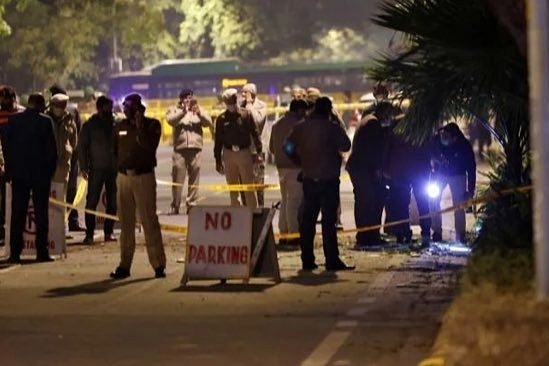Insta
Delhi Police Arrests Four Students From Kargil In Connection With Blast At Israel Embassy In Capital

Investigators at the blast site near Israel embassy in Delhi (@AviBenlolo/Twitter)
The Delhi Police Special Cell has arrested four students from Kargil in connection with the low-intensity IED blast near the Israeli Embassy in January.
In a joint operation with a central agency and local police, the Delhi Police Special Cell had picked up the students, all residents of Thung village, from Kargil and brought them to Delhi on Thursday (24 June).
The four students have been identified as Nazir Hussain (26), Zulfikar Ali Wazir (25), Aiaz Hussain (28), and Muzammil Hussain (25), reports The Indian Express.
Aiaz Hussain is learnt to have graduated from Ramjas College in Delhi; his brother Muzammil Hussain is a post-graduate (Botany) from Panjab University. Zulfiqar Ali is doing his post-graduation in Commerce (distance learning) from Dyal Singh College in Delhi; Nazir Hussain is doing his post-graduation in Physical Education from Panjab University.
“They (students) were held in connection with a conspiracy to plan and execute terror activities in the national capital. We have taken them on transit remand and brought them to Delhi for questioning,” said a statement issued by the PRO office.
A very low intensity improvised explosive device went off at about 5.05 pm on 29 January at APJ Abdul Kalam Road near the Embassy of Israel in New Delhi.
Window panes of several cars parked there were shattered with the impact. After the blast around 5.11 pm, the investigators recovered a letter addressed to the Israeli Ambassador to India, Ron Malka.
The letter was addressed to “The Terrorist, Devil of Terrorist Nation Dr Ron Malka” and was written by someone who identified himself as “Sarallah India Hezbollah”.
Support Swarajya's 50 Ground Reports Project & Sponsor A Story
Every general election Swarajya does a 50 ground reports project.
Aimed only at serious readers and those who appreciate the nuances of political undercurrents, the project provides a sense of India's electoral landscape. As you know, these reports are produced after considerable investment of travel, time and effort on the ground.
This time too we've kicked off the project in style and have covered over 30 constituencies already. If you're someone who appreciates such work and have enjoyed our coverage please consider sponsoring a ground report for just Rs 2999 to Rs 19,999 - it goes a long way in helping us produce more quality reportage.
You can also back this project by becoming a subscriber for as little as Rs 999 - so do click on this links and choose a plan that suits you and back us.
Click below to contribute.
Latest